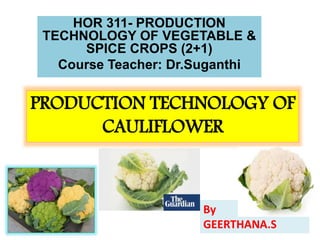
Geerthana production technology of cauliflower
- 1. PRODUCTION TECHNOLOGY OF CAULIFLOWER HOR 311- PRODUCTION TECHNOLOGY OF VEGETABLE & SPICE CROPS (2+1) Course Teacher: Dr.Suganthi By GEERTHANA.S
- 2. Common name: Cauliflower Scientific name: Brassica oleracea L. var. botrytis Family : Brassicaceae Order : Crucuferae Tribe : Brassicae Sub-tribe : Brassica Origin : England (Dr. Jemson) Chromosome no.: 2n=18 Latin word CAULIS- STEM FLORIS- FLOWER
- 3. AREA & PRODUCTION Largest producer- India Major producing states- West Bengal (26%), Bihar (17%), Madhya Pradesh (10%), Orissa (10%), Gujarat (8%), Haryana (7%), Assam (6%) and Maharashtra (3%) IMPORTANCE & USES Used as cooked vegetable Used for the preparation of pakoras Grated cauliflower used to prepare stuffed parathas Preparation pickles with other vegetables
- 5. Difference b/w Indian and European Cauliflower Characteristics Indian Cauliflower European Cauliflower Heat tolerance Yes No Curd formation at 20-27ᵒC 5-20ᵒC Maturity Early Late Variability More Less Self compatibility Strong Less or No Curd color & flavour Yellow & Strong White & Mild Juvenility Short Long Requirement of vernalization No need but requires cold treatment @ 10-13ᵒC for 6 weeks Require vernalization @ 7ᵒC for 8-10 weeks
- 6. BOTANY Seeds – head shaped Head of cauliflower-CURD –tightly packed flower buds that have not developed 4 petals,6 stamens(2-short & 4- long) Special pod- SILIQUA
- 7. EARLY VARIETIES Early Kunwari Pusa early synthetic- Main season variety Pant Gobhi-3- curds medium sized & solid white Pusa Deepali-self-blanching,free from riceyness Pant Gobhi-2
- 8. Improved Japanese-Introduction from Israel Pusa Hybrid-2 – resistant to Downy Mildew Pusa Sharad – semi-dome shaped Pant Gobi-4-hemispherical creamy white,non-ricey curds MID-EARLY VARIETIES
- 9. Pusa Synthetic Pant Shubhra- curd slightly conical & creamish white Pusa Himjyoti-self-blanched Punjab Jiant 35 MID-LATE VARIETIES
- 10. Pusa Snowball Pusa Snowball K 1 Ooty 1- Suitable for growing in hilly regions of TN above 1,800 MSL LATE VARIETIES
- 11. SOIL: • Sandy to heavy soils • Early crops-light soil; Late crops-heavy soil • pH 5.5-6.5 • Plants growing in saline soils are prone to diseases CLIMATE: • Thermo-sensitive crop • High temperature during maturity –yellow leafy curds • Seed germination-10-21ᵒC • Growth & curd formation- 15-21ᵒC
- 12. BOLTING • Premature formation of seed stalks • Fluctuating temp. induce some cultivars which have started heading, to revert vegetative phase – poor quality curds • Early crop-500-600 gm seeds • Mid & late crops- 350-400 gm seeds SEED RATE
- 13. TRANSPLANTING Germinated seeds are transplanted after 30-40 days of sowing SPACING- Early Varieties 60*30 cm Mid & late season varieties 60*45 cm
- 14. Manures & Fertilizers: 25-30 tons of FYM 100-150: 60-80:80 kg NPK per ha Later 1-2% urea is sprayed –enhance plant growth(@ 7-10 days interval on young plants) Irrigation: 10-12 days interval Over watering & water logging should be avoided
- 15. BLANCHING • The developing curd of the spreading plant type is often covered with the leaves of cauliflower removed from the plant or by tyeing the upper leaves for blanching the curd so that it does not become yellowish when exposed to the sunlight. • The ultraviolet rays of the sunlight affect the curd colour. In the erect or semi-erect plant types of late varieties the small terminal leaves cover the developing curd and protect it from sunlight. • The market demands cauliflower which is pure white or pale cream in colour. Heads exposed to sunlight develop a yellow and/or red pigment. • The usual method to exclude light is to tie the outer leaves when the curd is 8 cm in diameter. Leaves may also be broken over the curd to prevent yellowing. • In hot weather blanching may take 3 to 4 days, but in cool weather, 8 to 12 days or more may be required. The new orange and purple- coloured cauliflower curds generally do not require blanching.
- 17. YIELD: Sorting and Grading • Harvesting of cauliflower-7 March • Cauliflower should be harvested when the head is approximately 15 cm in diameter, the curds are compact and white, the leaves are still healthy and green. • Harvested cauliflower for the fresh market is cut at the base of the head. The spreading leaves are removed; leaves that wrap around the head are trimmed 5 cm above the head for protection of the curd. • The heads are then cleaned, packed into cartons and then shipped to the cooler. Sometimes the heads are wrapped in perforated plastic. If the heads are wrapped in plastic, the carton is cooled by hydrovac. • If the heads are not wrapped in plastic, the carton is cooled by hydro- cooling. Cauliflower is packed with 6, 8, 9, 12, 15, 18 or 22 heads per cardboard box. • Nine or 12 heads per carton are the most desirable size. Cauliflower that is to be processed is packed into bulk bins and shipped to the packinghouse. In the packinghouse cauliflower is inspected for defects, trimmed, washed with mildly chlorinated water and then packaged. Most cauliflower is freshly processed and cut into florets for bagging, some cauliflower is processed for pickling. Early variety 10-12 tons Mid & late season variety 20-30 tons
- 18. IMPORTANT DISORDERS • Riceyness • Fuzziness • Leafy curds • Blindness • Buttoning • Chlorosis • Hollow stem • Browning • Whiptail • Damping off • Leaf spot & Blight or Black spot • Club root • Stalk rot • Downy mildew • Rhizoctonia • Black Rot IMPORTANT DISEASES
- 24. CAULLINIVAR
- 26. Post-harvest control: Cauliflower should be handled carefully to avoid bruising and damage that will leave the plant susceptible to infection. Plants must be thoroughly cleaned and stored at a low temperature, typically 4 °C. It is important to keep the storage facility free of soft rot bacteria by immediately destroying any infected plants and maintaining a clean facility.